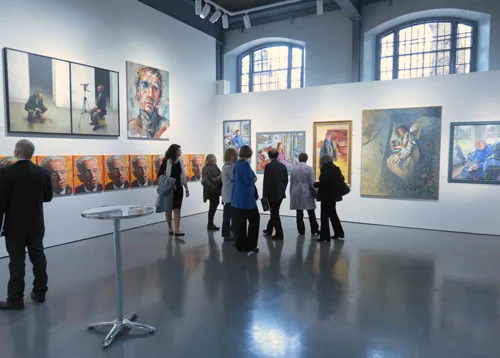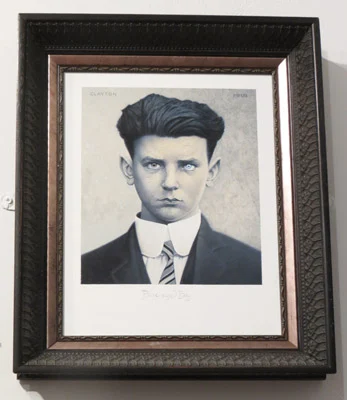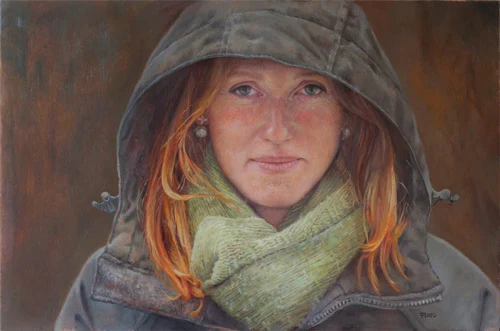The
121st Annual Exhibition of the
Royal Society of Portrait Painters has a particularly strong set of portraits which came via the open entry.
Indeed this is an exhibition where
45% of the works exhibited came via the open entry - despite the fact that competition for a place in the exhibition is becoming more intense every year. I've got more details - and numbers - about the in a separate post
Analysis of open entry to RSPP Annual Exhibition
Last week I highlighted
the portraits and artists which/who had won prizes in
Antony Williams wins Ondaatje Prize 2012
In this post I'm going to give you my general impressions of the exhibition. I'm also going to highlight some of the portraits which caught my eye. Speaking personally, I thought that portraits by non-members provided some of the more interesting portraits on display, even though most were typically smaller than the works by members which are on display.
The first thing to say is that
this is a very strong exhibition. To my mind the quality of this year's exhibition rivals that of the entries typically seen in the BP Portrait exhibition on the other side of Trafalgar Square. Which is hardly surprising since the society's members include a number of people who have won the BP or been finalists.
The RSPP are to be congratulated working their way through the
1,347 images entered in 2012 to reach the 217 which you can see in the exhibition.
- Portraits by members can mainly be seen in the West Gallery and the Threadneedle Space
- Portraits from the open submission can mainly be seen in the North Galleries
- [UPDATE: The Mall Galleries has just created a new Facebook photo gallery for the Royal Society Of Portrait Painters Exhibition in which you can see yet more portraits in the exhibition]
 |
Portraits in the Threadneedle Space
- a splendid new space for the bigger and more colourful portraits |
 |
West Gallery - Private View afternoon
The Private View always attracts lots of guests - including people who want to commission portraits |
Commissioned Portraits
One of the unique aspects of this particular exhibition is the extent to which portraits on display are not for sale. This is because they are very often commissioned by various august bodies and/or families without any intention of offering the painting for sale.
Instead, the exhibition makes an excellent shop window for the commissioning process - with benefits for both artist and
those commissioning work.
There's no way of getting away from the fact that a number of clients like to have a very classic portrait. Or that some RP members do a very good job in providing these. For example, I can perhaps best sum up
Keith Breedon RP's portraits of "
people in a position" by quoting what I wrote down in my catalogue - they look like 'real people'.
This year this has tended to point up the contrast between the RSPP members and the open entry. In particular, the open entry tends to reflect contemporary life rather better than the commissioned portraits of military bods, university chancellors, bishops and wealthy families.
However there are some very experienced non-members who also produce large commissioned portraits.
I spotted this portrait in the North Gallery and for me it's luminous and yet real despite its lack of a contextual background. It turns out that this portrait of
The Wards is by
Paul Benney who has a well established portrait practice on both sides of the Atlantic. He was invited to display his work by ex-President
Daphne Todd OBE PPRP NEAC. I do like the way his website indicates he paints more than just portraits. One also gets a sense from his portfolio of portraits that he does like to paint interesting coloured garments. The colours in the portrait are helped enormously by the variation in colour of the background. I do like portrait artists who paint an optically interesting background - it seems to energise the painting.
 |
The Wards by Paul Benney (NFS)
95 x 130cm (37 x 54 inches)
© Paul Benney |
Works which caught my eye
It's perhaps invidious this year to single out individual portraits and their artists because the exhibition is in general very strong.
Three portraits of women by prize-winning
portrait artist Michael Taylor RP made a very striking image in the West Gallery. These paintings reflect his interest in painting figures and his skill in composition - which accounts for why the design and content of the images are so interesting. These are images which make me feel they are present in the room with me and I want to ask them questions about what it's like sitting for Mr Taylor.
Michael Taylor's self-portrait drawing has recently been acquired by the National Portrait Gallery. he also has three other portrait paintings in the NPG.
 |
Three portraits of women by Michael Taylor RP
Seated figure with helmet £19,500
Ancestral Portrait (Korean Style) £20,000
Seated figure with helmet (£19,500
oil paintings
© Michael Taylor
|
This portrait
Not Fade Away by
David Cobley RP RWA NEAC commanded a lot of attention and got a lot of comment. It's an intriguing portrait with a number of allusions within the painting. I thought I spotted some wings.
 |
Not Fade Away by David Cobley RP RWA NEAC
oil, 183 x 152cm (72 x 60 inches)
© David Cobley |
 |
Anthony by Miriam Escoffet
oil, 89 x 69cm (35 x 27 inches)
© Mirian Escofet |
I think Anthony by
Miriam Escofet caught my eye because the subject is not looking at the artist - but is instead looking at something outside the picture frame. Having reviewed her website I can see this is an artist who is absorbed by how she can transform space. She has a fascinating section of her website where she demonstrates
how she progresses a work.
Tomas Clayton's
Blue-eyed Boy's eye literally caught my eye despite being a small painting hung high on a wall.
 |
Blue-eyed Boy by Tomas Clayton
0il on masonite, 20x23cm (8x9 inches)
© Tomas Clayton |
The far north gallery contains an enormously poignant portrait of an old man titled
Waiting by
Sue Spaull (who needs to get her website sorted pronto!). This again created a context for the portrait which spoke volumes about the individual.
 |
Waiting by Sue Spaull (invited by Brendan Kelly RP)
oil
© Sue Spaull
|
I loved the three highly accomplished drawings in charcoal by
Geoffrey Hayzer RP. This is an exhibition which always appreciates a finely executed drawing.
 |
Three charcoal drawings by Geoffrey Hayzer RP (NFS)
© Geoffrey Hazer |
The exhibition also includes portraits by art bloggers
Sophie Ploeg (
The Art-Ventures of Sophie Ploeg) and
Olha Pryymak (
Olha Pryymak). I had the pleasure of meeting up and having lunch with Sophie and her model Emma - and it's an excellent likeness of Emma. See Sophie's review of the exhibition here -
Royal Society of Portrait Painters
 |
Autumn by Sophie Ploeg (NFS)
oil, 74x54cm (29 x 21 inches)
© Sophie Ploeg
|
 |
People I know: Nabil by Ohla Pryymak (£375)
oil, 19 x 19cm (7 x 7 inches)
© Ohla Pryymak |
In general, I very much liked the hang, although I thought the new Threadneedle Space was better suited to strong and colourful paintings and I'm not sure it needed a 'quiet wall'. Quieter paintings seem to fare better in the smaller and more intimate North Galleries - which in this instance had a lot of traffic on the day I visited.
Events during Exhibition
The RSPP always makes sure that there are a number of good quality events during the course of their exhibition. The following events will take place before the exhibition closes on 18th May 2012.
The similarities between the role of the photographic portrait and the role of the painted or drawn portrait have created tension with practitioners since the invention of the photograph. Clearly, however, artists have been making use of the lens as part of an image capturing process for centuries. Is it wrong then for a portrait artist to use photography to help paint a sitter and if so, why? For instance, what do portrait photographers look for in their subjects that differs from that of the portrait painter and what can portrait painters achieve that their counterparts cannot? Does the use of photography within portrait painting extend the possibilities or does it impede them? How can the use of photography and video enable the artist to create broader contemporary insights into a subject or comment upon mass media itself?
You can visit the exhibition can be seen at the
Mall Galleries until 18th May 2012, 10am to 5pm (open until 7pm Thursdays). Admission £2.50, £1.50 concessions (Free to FBA Friends, National Art Pass holders, Westminster Res-card holders and under 16s)

 The Making A Mark Poll - Resources for Artists
The Making A Mark Poll - Resources for Artists


































